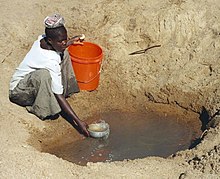
Back ندرة المياه في إفريقيا Arabic Escassetat d'aigua a l'Àfrica Catalan Escasez de agua en África Spanish Ur eskasia Afrikan Basque Pénurie d'eau en Afrique French Kelangkaan air di Afrika ID Enweghị mmiri n'Africa IG Water Scarcity in Africa PCM Letlhôkô la metsi mo Aferika Setswana

Water scarcity in Africa is likely to reach dangerously high levels by 2025. At this date about two thirds of the world's population may suffer from shortages of fresh water. The main causes of water scarcity in Africa are physical and economic scarcity, rapid population growth, and climate change. Water scarcity is the lack of fresh water resources to meet the standard water demand.[1] Sub-Saharan Africa does have a plentiful supply of rainwater. But it is seasonal and unevenly distributed, leading to frequent floods and droughts.[2] Also economic development and poverty issues and rapid population growth and migration to cities have made Sub-Saharan Africa the world's poorest and least developed region.[2][3]

The Food and Agriculture Organization of the United Nations reported in 2012 that growing water scarcity is now one of the leading challenges for sustainable development.[4] This is because an increasing number of river basins have reached conditions of water scarcity. The reasons for this are the combined demands of agriculture and other sectors. Water scarcity in Africa has several impacts. They range from health, particularly affecting women and children, to education, agricultural productivity and sustainable development. It can also lead to more water conflicts.
To adequately address the issue of water scarcity in Africa, the United Nations Economic Commission for Africa emphasizes the need to invest in the development of Africa's potential water resources. This would improve food security and water security, and protect economic gains by effectively managing droughts, floods, and desertification.[5]
- ^ "Water Scarcity | Threats | WWF". World Wildlife Fund. Retrieved 2020-11-29.
- ^ a b "International Decade for Action: Water for Life 2005-2015". Retrieved 1 April 2013.
- ^ Fox, Sean (February 2014). "The Political Economy of Slums: Theory and Evidence from Sub-Saharan Africa". World Development. 54: 191–203. doi:10.1016/j.worlddev.2013.08.005. ISSN 0305-750X.
- ^ FAO (2012). Coping with water scarcity - An action framework for agriculture and food security, FAO Rome.
- ^ "Management Options to Enhance Survival and Growth" (PDF). Archived from the original (PDF) on 7 May 2020. Retrieved 18 March 2012.
© MMXXIII Rich X Search. We shall prevail. All rights reserved. Rich X Search